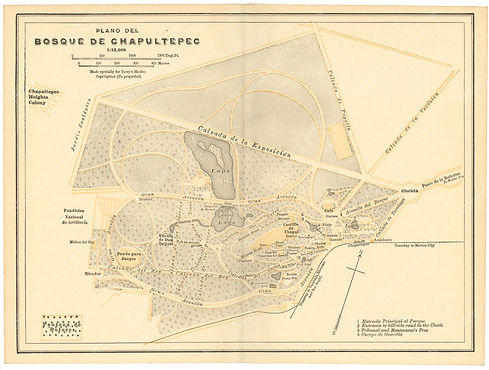Solving the Mexican Muller Mystery

The Full Story
The History of "Muller #1"

Creation
The "Mexican" Muller was created by the D.C. Muller Brothers Manufacturing Company sometime between 1903 and 1908. It is theorized to be the first carousel produced by the Muller Brothers after splitting off from the Dentzel Company.
Palisades Amusement Park, New Jersey
The owners of Palisades Amusement Park in New Jersey made a deal with the Muller Bros. Instead of buying the carousel outright, the park had the Mullers operated the carousel like concessionaires. Records vary, but the carousel cost between $5,000 and $25,000 to build. It began operating in 1908, and in 1909 a permanent, ornate roundhouse would be constructed, costing a reported $6,000, which is pictured on the right (with a later carousel inhabiting it). In 1913, the owners of Palisades wanted a bigger carousel, and Muller created a new, four-row carousel for the park. Some of the figures from the original Palisades carousel were removed and placed on the new four-row carousel, though it is unclear how many or which ones were removed. Muller worked on replacing the removed figures throughout 1915 and early 1916.


Atlantic Beach Park, New Jersey
The carousel operated from 1916 to an unknown date in Atlantic Beach Park, Atlantic Highlands, NJ. The park was also known as Bayview Park, Joy Land Park and, unofficially, Mandalay Park. The roundhouse where the carousel operated can be seen in the bottom center of the photo on the left.
We still need more information and photos--contributions are appreciated!
Chapultepec Park, Mexico
It is not yet known when the carousel moved to Chapultepec Park, or where exactly in the park it operated, but it may have been in the "Prado Para Jugoes" ("Lawn for Games") seen on the map to the right. The carousel operated in Chapultepec until 1932, when it was sold to the Sanchez family of Mexico City. It was then put into storage for 41 years.
The carousel operated again in 1973 at an unknown location, then returned to storage for 14 years before operating again in 1987.


Carnival & Hurricane Gilbert
The carousel was set up with a carnival called Juegos Manzo in the Santa Catarina riverbed by the Pope's Bridge in Monterrey, Mexico. The river had been mostly dry for over 50 years until 1988, when the river flooded due to Hurricane Gilbert and all of the amusements were destroyed, including the mechanism of the carousel. Luckily, the carousel's figures and chariots were safely in storage, and were therefore saved.
The photo to the left shows Juegos Manzo, prior to Hurricane Gilbert, with the Muller carousel visible (the largest tent covering, near the bottom left). In fact, Stander #1 and Stander #2 can just barely be distinguished when zoomed in.
The Higareda Brothers
The carousel's figures were sold to the Higareda family sometime in the early 1990s. During this time, it is believed that the Higareda family made various molds and/or copies of some of the figures.
The figures were transported from Mexico to the United States to be sold.


The Silent Auction
A silent auction was organized to sell 49 of the figures. It was scheduled for September 17, 1994, in New Waterford, Ohio.
The original auction was a colossal failure, with only six figures selling for $5,000 each. The figures were originally grouped into lots of three: one stander, one middle-row jumper, and one inner-row jumper. The prices were also extremely high, with the lot including the "rose horse" (featured on the advertisement to the left) having an asking price of $255,000. The extremely high prices, sale by lots, and silent auction format were all cited as reasons for low attendance. Furthermore, people were required to pay a $100 entry fee, regardless of whether or not they were bidding.
Post-Auction
After the auction, additional advertisements went out in an effort to sell the other figures. They were sold individually this time, and split up for good. They appeared in various auctions in the mid- and late-90s, where they moved between private owners and collectors with very little information or photos available.
After this point, we have little to no knowledge as to the whereabouts of these beautiful figures. Several figures have been restored over the years, with articles appearing in The Carousel News & Trader about them, and they occasionally appear for sale online. It is safe to assume that most of the figures belong to private collectors or belong to museums. It is also unfortunately possible that some of these figures have been destroyed, either by natural disaster such as fires or floods or being disposed of by those who don't know their value.


The Future
It is my hope that, with the help of the wonderful carousel community, museums, and historians, I can piece together more of this carousel's history. Although I recognize that it is extremely unlikely, I would like to locate most, if not all, of these figures and gain modern photos of them, as well as any restoration information. Thank you for reading and joining my journey to preserve this beautiful carousel for future generations!